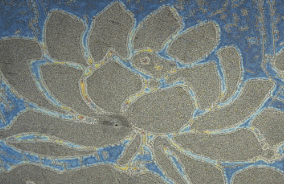Researchers Developed A Simple yet Powerful Approach for the Fabrication of Breath-taking Patterns
Date:01-11-2017 | 【Print】 【close】
Surfaces patterned with hydrophilic and hydrophobic regions provide robust and versatile means for studying the wetting behaviors of liquids, analyzing surface properties, and producing patterned arrays. However, how to fabricate integral and uniform arrays into the open systems remains a challenge, thus restricting these arrays from being used in practical applications.
Prof. DU Xuemin and his colleagues, from Shenzhen Institutes of Advanced Technology, Chinese Academy of Science recently developed a simple yet powerful approach for the fabrication of breath-taking patterns, which can be widely used for information storage and biochemical sensors.
This strategy can be used for not only the formation of water droplet arrays, but also the assembly of photonic crystal bead arrays on hydrophilic−hydrophobic patterned substrates. Various integral arrays are in large-yield preparation with a high quality, low cost, and uniform size control. By simply breathing onto the substrate surface, the moisture coming from the breath would condense and make the complex hydrophilic−hydrophobic outlined images visible in the discontinuous hydrophilic regions. Integration of hydrogel photonic crystal bead arrays into the “breath-taking” process results in breath-responsive photonic crystal beads, which can change their colors upon a mild exhalation. This state-of-art technology not only provides an effective methodology for the preparation of patterned arrays but also demonstrates intriguing applications in information storage and biochemical sensors.
The paper titled “Breath-Taking Patterns: Discontinuous Hydrophilic Regions for Photonic Crystal Beads Assembly and Patterns Revisualization” was published in the ACS Applied Materials & Interfaces on October 9, 2017. This work is supported by the National Natural Science Foundation, Guangdong Innovative and Entrepreneurial Research Team Program and Shenzhen Peacock Plan.

Figure 1. (A) Illustration of the formation of a photonic crystal bead array; (B) Images of arrays of photonic crystal bead and their reflection spectrum; (C) The morphologies of the photonic crystal beads and the reflectance spectra. (Image by Prof. DU Xuemin)

Figure 2. Exhale onto an invisible image, the water vapor in the breath condenses on the surface and make the image visible; the image becomes invisible when the water vapor evaporates, the image is invisible again. (Image by Prof. DU Xuemin)

Figure 3. (A) Images of exhaled airflow visualization of invisible images; (B) The reflectance spectra of the breath-responsive photonic crystal beads. (Image by Prof. DU Xuemin)
Prof. DU Xuemin, Ph.D Principal Investigator
Shenzhen Institutes of Advanced Technology, Chinese Academy of Sciences
Shenzhen, Guangdong 518055, China
Tel:00-86-755-86582652
E-mail:xm.du@siat.ac.cn
